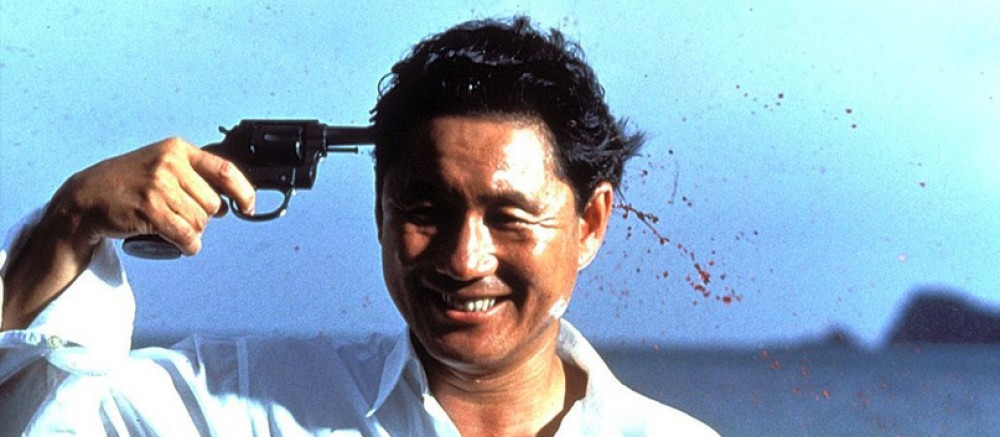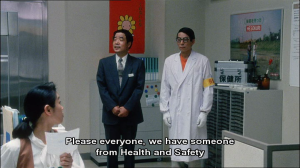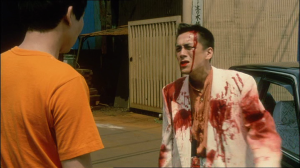“When people tell me I’m an artist, I say what? It’s impossible for me to take the idea seriously. So I just wanted to have fun here. Psychologically, I’m still a 12-year-old boy.” (Kitano, Rose)
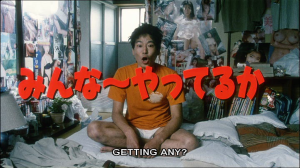
One is inclined to view Kitano’s body of films as a process of maturation; as one follows his films in order, we can find his thematic concerns such as mono no aware and his use of violence becoming more nuanced and intelligent. His first 4 films culminate in Sonatine(1993) and two films later, he produces what is perceived as his masterpiece, Hana-Bi(1997), which won the Golden Lion at the Venice Film Festival. However, between them, lies Getting Any(1995), an extremely polarizing work. Getting Any was a financial and critical flop, abroad and at home. A film full of crude sex jokes and scatological humour, it seems at odds with the output that Kitano is known for in Europe- these meticulously paced films. This is because Kitano has an alter ego unbeknownst to European audiences; Beat Takeshi.
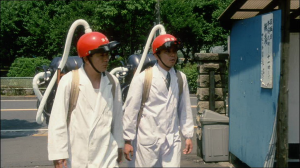
Beat Takeshi was a satirist, captivating the teenagers of Japan with his black humour while not caring what the rest of ‘decent’ Japan thought. “Takeshi escaped from the convention of graduating from university to become what he called “a member of society”. He turned his back on life as a ‘sensible adult’ and chose instead to keep on acting like a child.” writes Tomihiro Machiyama, a man who grew up an avid fan of Kitano’s late night radio shows, where he discussed shock humour with his teenage audience and other puerile topics
He worked as part of the Two Beats comedy group before his radio show, both attacking and supporting the traditional manzai comedy duo structure by making it appeal to a younger audience and using very little of the rigid structure that the traditional manzai utilized. “The best-known Two Beats joke is a parody of a public transport safety slogan which goes, “Cross when the traffic lights are at red, like everyone else and you will be safe.” Initially, that was attacked for encouraging children to break road safety rules. Eventually. however, people came to see it as poignant criticism of the collective psychology particular to the Japanese -i.e. ‘If you can’t beat ’em, join ’em’.” (Machiyama) We can see from that example, that Beat’s humour is directly aimed at Japanese audiences, and since Getting Any is a Beat Takeshi film, the humour, and cultural references for the most part are incredibly difficult to discern for a western audience.
Describing the plot in Getting Any is rather pointless. It starts with a simple minded man wanting to buy a car for sexual exploits. Eventually all his exploits and plots fails to claim the fairer sex.
Kitano dresses Dankan up like one of Japan’s most notorious figures, the poisoning bank robber.
His exploits reference other Japanese films and important cultural events. To join the yakuza, Dankan, our main character, kills a character called Joe Shishido- named after a famous yakuza genre actor, who rather suave in comparison to this Joe. It makes references to the Teikoku Bank robbery, dressing Dankan up like the man who killed 12 people, as he tries to rob a bank. He Tries become an actor, and ends up playing Zatoichi, the popular blind samurai character, on a film set, where he causes chaos by accidentally throwing ladles of faeces around the set. The final third apes Godzilla vs. Mothra, Ghostbusters, The Fly, and Ultraman in it’s campy aesthetic and costumes.
The plot is perfunctory, it is only the barest of bones with which Beat Takeshi uses to satirise the giants in Japanese culture. The film is rather, an assault on our decency and senses of moral order, as Dankan robs banks, steals cars, joins the yakuza and becomes a giant fly as a result of his attempts to have sex.
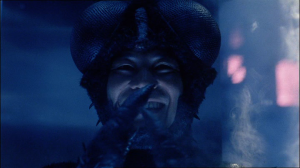
Getting Any is outrageous, though is it funny? The humour and gags are stiff, references exist only for their own sake, and the universe that Dankan inhabits goes from being a recognizable Japan for foreigners, and becomes a trip inside the collective Japanese mind. Getting Any can be viewed as both a venting of Kitano’s childish side, and an expression of his refusal to be pigeon-holed, a trend that sees him balancing both sides of his career. “According to his producer, Masayuki Mori, who has known him for 30 years, Kitano’s career is like a pendulum. “The more serious he gets in his films, the stronger he swings back to the other side, and the more absurd and stupid his TV shows get. He really needs to do both to be him.” (Rose)
Why did Takeshi Kitano turn to Beat, just as he was on the cusp of solidifying all the film craft progress he had expressed? this question can be answered by looking at trends in Kitano’s life.
Yakuza tropes are parodied quite heavily in Getting Any, as Kitano pokes fun at his newer body of work.
Kitano is a man that resists structures; “Another explanation would be, that Kitano, as he always does when he is pushed, pushes back: If they want to laugh at me on screen, then I?ll give them something to laugh at. In a recent interview, Kitano said, “I wanted to make fun of my own jokes, and send them up. So I made up new routines which were more outrageous than the silliest ones I usually invent. I wanted to make myself ludicrous to the point where viewers would say, ‘This guy’s had it’. I enjoyed my self-mockery so much I totally lost myself in it.” (Sylow) Kitano himself described Getting Any as creative suicide, a cleansing of his artistic concerns. Getting Any is both a return to the Beat Takeshi humour and a deconstruction of the structures others impose on Kitano, serious or comedic. “until recently Japanese audiences have largely ignored Kitano’s movies, which only found an audience when they were praised by European critics. He saves his arthouse auteur persona for when he’s overseas.”(Rose) For the European market, we know of Takeshi Kitano as the near mute, stoneface, a man of filmic integrity, the purveyor of long takes and brutal violence. However, in Japan, his first foray into the public eye was through comedy, and it is to comedy he returns in Getting Any, though with a withering eye towards his own ‘Beat’ persona. Kitano’s total body of work is representative of both sides of Japanese aesthetics. One side is serene and noble, the other peeps into ladies bathrooms. After years of being raucous and offensive as Beat Takeshi, did he then take to directing serious films. It seems that to reach the highest heights of ‘maturity’, Kitano feels the need to express his childishness to the fullest. Rather than continue in this vein of failing to achieve acclaim in his native country, and finding it in Europe, Getting Any is an aggressive attack on both sides of his double life.
Works Cited
Machiyama, Tomohiro. “A Comedian Star Is Born.” Welcome to Kitano Takeshi . Com. N.p., n.d. Web. 12 Feb. 2013.
Rose, Steve. “Takeshi Kitano: One Original Gangster.” The Guardian. N.p., n.d. Web.
Sylow, Henrik. “Biography.” Welcome to Kitano Takeshi . Com. N.p., n.d. Web. 12 Feb. 2013.
